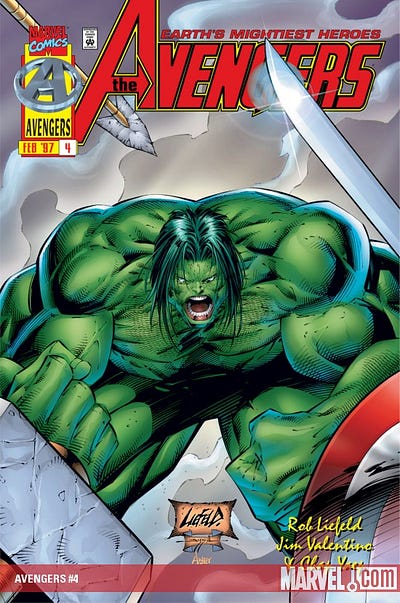Unless you’ve been living on Skrullos (one for the Marvel fans) for the past year, you’ll know that there’s a new Avengers film out. What you may not know is that “Earth’s Mightiest Heroes” can teach you a fair bit about the art of creating great thought leadership. From Thor via Black Widow through to Hulk, the green rage machine himself — great thought leadership relies on six key principles.

The Captain America approach
Steve Rogers, or Captain America as he’s better known, is the heartbeat of the Avengers. Through his selfless leadership, he rallies and bonds the disparate members of the Avengers. And the leadership bit of thought leadership is paramount. Opinions and thoughts are everywhere — in the world of Twitter, comment boxes and Facebook, everyone has become an “expert” on everything. To create truly effective thought leadership, your organization needs to lead the debate.
They need to lead by sharing a clear vision and persuading others to follow. Thought leaders need to back their commentary with data, research and examples. And crucially, thought leaders must deliver insights and advice to an intelligent, media-savvy audience that isn’t satisfied with bland opinion.
One of the key challenges is leading the conversation in an overcrowded market — in Acuris Studios space, this could be general M&A; private equity buyouts or cross-border dealmaking. The key to success with this type of thought leadership is not to shout loudest but to find an innovative and robust way to deliver the message.
Insight: Don’t shout; hone your opinions; use the data and lead the debate

The Black Widow Approach
Black Widow, the only female member of the Avengers, is an expert tactician, an effective strategist and a maestro in the art of subtle persuasion (as well as being able to kick the hell out of her adversaries). Thought leadership needs that level of persuasion and subtlety. It is not the same as advertising. Unlike a 30-second TV advert, an online campaign or a double-page spread in GQ or Bloomberg Business, thought leadership is about building the story subtly rather bludgeoning the audience with aspirational messages.
This type of quiet yet powerful messaging allows thought leaders to take more time to get their insights across. In addition, thought leadership is more than just a one-shot deal , it allows you to use more sophisticated methods of distribution — be this in print, video or online (or most impressively, a combination of all three).
This merger of understated messaging and sophisticated distribution channels allow thought leaders to build the debate without the need to yell from the rooftops about how great your business is or rope in a celebrity to validate your brand.
Insight: Use subtlety both in message and approach to lead the debate. Don’t bludgeon the reader

The Thor approach
Thor, the god of thunder, is not only an immortal deity but a man of action. He has thousands of years of experience battling villains across galaxies and he is not afraid to wield his hammer, Mjolnir, to make his point. If you are to follow the Thor approach to thought leadership, you need to show your experience and knowledge and, well, hammer home your points.
Any Hollywood executive will trot out the mantra: “Show, don’t just tell”. This also holds true for the best thought leadership. For your message to resonate with your audience, you need to demonstrate your experience and expertise by nailing (no more hammer puns, promise) each of your assertions with robust data, pertinent examples and complementary quotes from other notables within the industry.
More than any other medium, thought leadership allows organizations and individuals to prove their experience and knowledge and put themselves at the forefront of their field. This is particularly true for two contrasting cases — complex or abstruse areas that need clear exposition and broader fields where there are already a multiplicity of entrenched opinions.
Insight: Show don’t tell

The Iron Man approach
Scientist Tony Stark, better known as Iron Man, may be brash and occasionally selfish, but he is a genius who is well ahead of his field. He has saved the world on numerous occasions — although he also created Ultron (Spoiler alert: that doesn’t work out so well). As a thought leader, nothing beats being at the cutting edge.
A report that is truly groundbreaking or adds new perspectives to debates distinguishes your organization from the competition and will be noticed by your peer group and beyond. Back this with world class data and the world will sit up and take notice — even better if you’re wearing a high-tech metal suit.
Of course, recognizing trends early is not easy and then backing these with the necessary data can often be complex, but, given the right resources and data, it can be done with great success.
Insight: Educate and innovate

The Hawkeye approach
Hawkeye is the quiet one in the Avengers, but don’t let that fool you — he is a master archer who always hits the mark. One method to providing effective thought leadership is to narrow your focus and go for pinpoint precision. Rather than taking a widescreen view of events, it is often preferable to hone in on one particular angle, sector or region and explore this with forensic precision.
This can be more tricky than taking a bird’s eye view, yet it can often be more rewarding for the reader as it allows the piece to go into greater depth and provide solutions to a subject that may not be getting that much ‘air time’.
The key here is to have clear and precise insights and solutions, and to know the subject matter inside-out.
Insight: Narrow your focus and hit the mark

The Hulk approach
When it comes to the Hulk’s path to thought leadership success, we’re not advising growing in size, turning green, splitting your trousers and raging against anything and everything in sight. If you are looking to spark discussion and build the debate, then your thought leadership shouldn’t be afraid of controversy and even, a little anger.
Of course, this does not mean being offensive or contentious for the sake of it — but you should be ready to make a stand that may be unpopular (if you can back it up, of course). Being provocative and passionate means that you may not connect with all people, but it will put you in front of the right people. Readers won’t engage with bland content. Well-argued, thought-provoking and thoroughly-researched thought leadership is opinionated without being offensive, controversial without being crude and insightful rather than insulting. This type of thought leadership will get you noticed — but, like the Hulk, be prepared for a battle.
Insight: Be fearless, be strong but never lose sight of the facts.